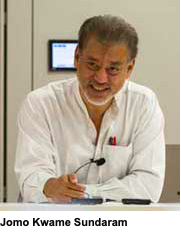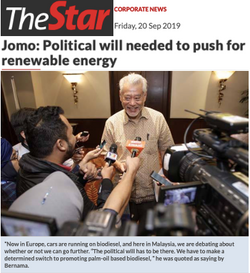- Aug 13, 2020
- 5 min read
Anis Chowdhury and Jomo Kwame Sundaram
SYDNEY & KUALA LUMPUR: Developing country debt has continued to grow rapidly since the 2008-2009 global financial crisis (GFC). Warnings against debt have been reiterated by familiar prophets of debt doom such as new World Bank chief economist, Carmen Reinhart, once dubbed the ‘godmother of austerity’.

Growing debt burden
Falling commodity prices, dwindling foreign reserves, slower global growth and weakening currencies have made it harder for developing countries to meet external debt payments.
This has involved economies of all income categories, reaching historical highs even before the pandemic. By early May, more than 100 countries had asked the International Monetary Fund (IMF) for help.
Developing countries’ government debt is likely to worsen with the pandemic induced recessions, triggering appeals for urgent debt standstills, cancellations and restructuring. While accumulated debt is undoubtedly problematic, debt phobia is now limiting fiscal options for coping with the worst economic downturn since the Great Depression.
In March, the United Nations called for a US$2.5 trillion package for developing countries to cope. By May, IMF Managing Director Kristalina Georgieva warned that the need is far greater.
While the Trump administration blocked the latest IMF Special Drawing Rights (SDRs) initiative, other debt relief initiatives, e.g., by the G20 and the IMF, are quite inadequate. Even David Malpass, the Trump nominated World Bank president, has criticised the G20 for falling short on debt relief, insisting “more needs to be done”.
Debt buybacks hardly novel
Surprisingly, rather than seeking to finance stronger fiscal responses to Covid-19 recessions, Joseph Stiglitz and Hamid Rashid have joined the chorus to address “catastrophic debt crises”, offering no evidence they are “impending”.
They discuss various options for debt relief and restructuring, and offer guidelines for bond buybacks, without mentioning April proposals by the UN, UNCTAD, the African Union and the UN Economic Commission for Africa.
While recognizing some limitations, the duo insist “bond buy-backs present a highly attractive solution, offering substantial debt relief at a relatively low cost”, which “has not received sufficient attention”.
They urge the IMF to use its New Arrangements to Borrow to buy debt at a discount, supplemented by funds from donors and multilateral institutions, but offer no convincing evidence why debt buybacks should now be prioritised over fiscal resources for recovery.
Brady debt buybacks
Under a US-led debt buyback initiative, named after then Treasury Secretary Nicholas Brady, indebted developing countries purchased US Treasury bonds to collateralize more than US$160 billion in replacement ‘Brady bonds’ from 1989.
The scheme restructured the debt of 18 developing countries long after sovereign debt crises began in 1981, following the US Fed’s sharp increase of interest rates to kill inflation. Thus, governments helped banks take defaulted loans, trading for small fractions of their face value on illiquid secondary markets, off their books.
Some banks took ‘haircuts’, but still got much more than what was available in secondary markets. Unlike in the current era, US interest rates were high, and thus, countries bought the Treasury zero-coupon bonds at an attractive discount.
Bloomberg’s Sydney Maki argued on 5 May that a second Brady plan is unlikely to work. The Brady plan transformed commercial bank loans, many in default, into collateralized bonds, but government debt today is owed to more diverse creditors including New York hedge funds, Gulf sovereign wealth funds and Asian pension funds.
Maki doubts that fund managers’ fiduciary duties would allow them to be lenient, even if so inclined. Terms of many deals cannot be legally changed without approval from most bondholders.
Debt buybacks for whom?
As some have noted, the plan undoubtedly relieved “pressure on Wall Street”, saving large US commercial banks which had pushed loans to developing countries in the 1970s. Stock prices of US commercial banks with significant developing country loan exposure rose 35% by US$13 billion after countries accepted the deal.
Jeremy Bulow and Kenneth Rogoff noted that “when highly indebted countries retire their deeply discounted debt, either through buy-backs or ‘debt-equity’ swaps, they may simply be using their scarce resources to subsidize their creditors”.
For them, buybacks and debt-equity swaps “are by themselves a boondoggle benefiting … creditors”. Stiglitz and Rashid dismiss this as just a “possibility”, citing the 1988 Bolivian debt buyback and the 2012 Greek bond buyback as two “good examples” of success stories.
In fact, when Bolivia bought back US$308 million in debt at face value in 1988, the price rose to 11 cents from 6 cents on the dollar, lowering the market value of the remaining debt (US$362 million at face value) to US$39.8 million.
As the earlier market value of its total bonds (US$670 million at face value) was US$40.2 million, the buyback only reduced its debt by US$400,000. This miniscule reduction cost donors US$34 million, which Bolivia would have been better off investing otherwise.
Furthermore, debtor countries participating in the Brady plan were required to deregulate, liberalize and privatize, i.e., implement structural adjustment, to qualify for Fund-Bank money to supplement their own foreign currency reserves for buybacks.
Greek tragedy
Financed by European taxpayers, the Greek buyback experience was no better. The price of 10-year benchmark Greek bonds also rose, as yield fell 147 basis points following announcement of the buyback.
Former Greek Finance Minister Yanis Varoufakis observed, “rumours of a debt buyback have pushed these bond prices to above 43%”; “its effect will be a net debt reduction 40% less than the Eurogroup’s stated target”, constituting “a reward to hedge funds and a ruthless,… massive involuntary haircut for Greece’s embattled banks”.
The New York Times agreed that the “bigger winners were hedge funds, which pocketed higher profits than many had expected”, while Moody’s Analytics correctly predicted that the “bond buyback will not end Greece’s debt woes”.
Greece was forced into excruciating austerity, plunging it into economic depression. As the economy contracted by 24%, unemployment hit 26%, the highest in the euro zone, by September 2009, less than a year later. Thus, debt buybacks may well help financial markets, litigious funds and global finance, rather than indebted countries.
Bond buybacks no panacea
Undoubtedly, debt buybacks may sometimes work in favourable circumstances when well planned as part of a broader financing strategy. Ecuador’s 2008-2009 bond buybacks were part of its external debt restructuring to secure relief from illegitimate ‘odious debt’.
With no pressure from acute financial stress, Ecuador repurchased over 90% through financial intermediaries, at 35 cents on the dollar, as its bond prices fell during the GFC.
Jeffrey Sachs agreed with Bulow and Rogoff that debt buybacks are “not necessarily a panacea for heavily indebted countries” unless “part of a comprehensive arrangement” for reduction of all debt with the full participation of all creditors involved.
Writing before Brady, he doubted the feasibility of such debt reduction as the US had previously blocked such arrangements in the interest of US banks. The political influence of US financial lobbies has only grown in recent decades. And, as Maki notes, a comprehensive arrangement involving all creditors is an even taller order now as they are more heterogenous.
Furthermore, it was reasonable then to assume that debtors only had a certain amount to repay, with other prices adjusting accordingly. However, bond market prices today easily ‘overshoot’, while debt restructurings are rarely sufficient, often delayed and very costly.
Promoting buybacks, backed by institutions like the IMF, also runs the risk of encouraging holdouts in future debt restructurings.
Instead of using scarce financial resources to buy back bonds, multilateral institutions and donors should help developing countries retrieve fiscal space to urgently prevent Covid-19 recessions becoming depressions.























